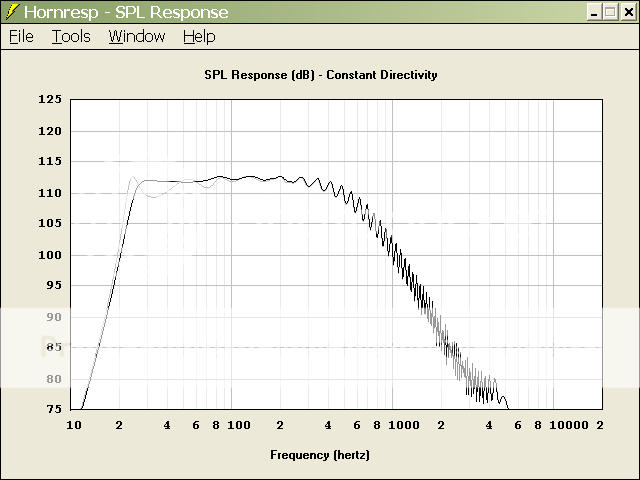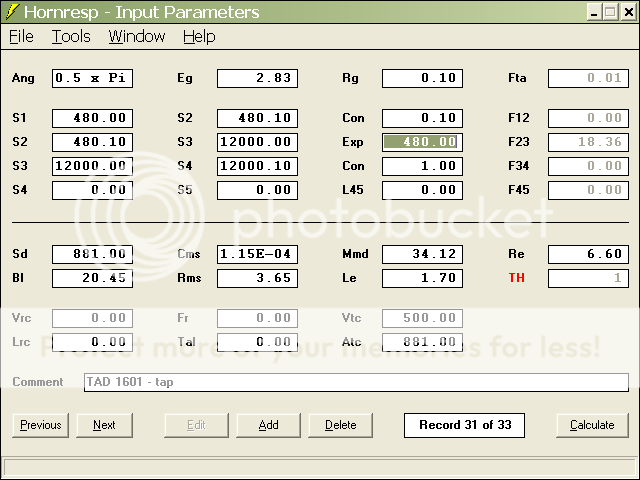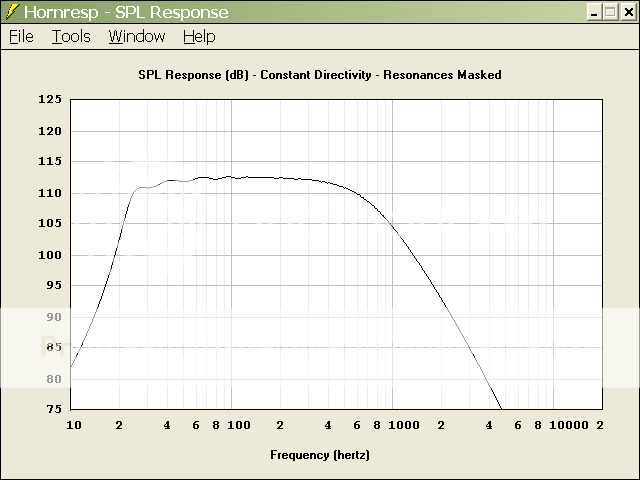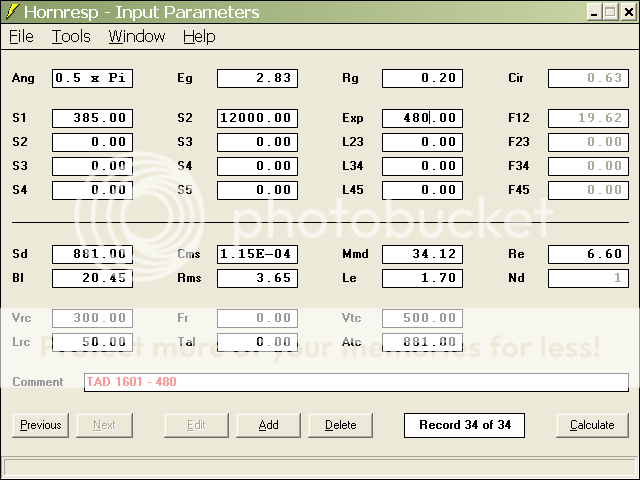Are the benefits of tapped horns limited to the lowest frequencies? I was thinking of making two tapped horn versions, one for the lowest frequencies <60 Hz and another pair for dedicated midbass frequencies (60-250). Is this a bad idea?
Hello,
as i wrote before:
http://www.diyaudio.com/forums/showthread.php?postid=1504411#post1504411
post 1758
look therefor my double horns.
i will give the
Mivoc WAL 416, 4", 16 Ohm, +-5mm stroke a try.
in a wall, table, armchair, sat-place sub double horn.
this kind of design

as i wrote before:
http://www.diyaudio.com/forums/showthread.php?postid=1504411#post1504411
post 1758
look therefor my double horns.
i will give the
Mivoc WAL 416, 4", 16 Ohm, +-5mm stroke a try.
in a wall, table, armchair, sat-place sub double horn.
this kind of design

Inspired by
http://www.diyaudio.com/forums/showthread.php?postid=1540782#post1540782
I managed to get this:

Exponential tapped horn! AWESOME! Big mouth! Heeeuuuuge cab!
(light grey is conical flare with all others being equal)
Data:

How amazing!
However, when I looked at the group delay and phase, those irregularities make me worried.
But then, a front horn with the same length appears to be in simular situation:


( I have to make the throat smaller and play with the back chamber a bit to get the smooth low end roll off... )
Oh, their group delays are pretty much the same, -30 ~ +40ms.
So, according to the simulations above, may I say the tapped horn can provide similar performance and sound quality as a front horn?
Recently I was stunned by a big front loaded bass horn. I'm wondering if tapped horn can perform the same, or even better.
Oh, these monsters!
http://www.diyaudio.com/forums/showthread.php?postid=1540782#post1540782
I managed to get this:

Exponential tapped horn! AWESOME! Big mouth! Heeeuuuuge cab!
(light grey is conical flare with all others being equal)
Data:

How amazing!
However, when I looked at the group delay and phase, those irregularities make me worried.
But then, a front horn with the same length appears to be in simular situation:


( I have to make the throat smaller and play with the back chamber a bit to get the smooth low end roll off... )
Oh, their group delays are pretty much the same, -30 ~ +40ms.
So, according to the simulations above, may I say the tapped horn can provide similar performance and sound quality as a front horn?
Recently I was stunned by a big front loaded bass horn. I'm wondering if tapped horn can perform the same, or even better.
Oh, these monsters!
loddie said:Are the benefits of tapped horns limited to the lowest frequencies? I was thinking of making two tapped horn versions, one for the lowest frequencies <60 Hz and another pair for dedicated midbass frequencies (60-250). Is this a bad idea?
Might be a bit complicated to avoid standing waves in the horn at 250hz, because a 250hz standing wave happens when a straight wall to wall distance in the horn is about 69cm or 27inch. Apart from this problem, it will work.
I am fixing to use some birthday money to buy the driver for the design that killjoy designed and Don Snyder folded up in post #1454. Has anybody built this design yet, and any tips on bracing it?
the only thing that buggs me is the out of passband distortion that will be created, and there is nothing that I can do about it except for resonators, but nobody has really pinned down yet how to implement them.
edit: ...actually on second thought, i just looked at the prices for that driver. $460 is ridiculous. I'm going to look back over the lab12 versions now...
edit: ...actually on second thought, i just looked at the prices for that driver. $460 is ridiculous. I'm going to look back over the lab12 versions now...
Chris8sirhC said:
$460 is ridiculous.
OK, then for a given bulk and F3, what driver(s) or pair of drivers yields a 'close enough' response, peak SPL and durability under pressure for appreciably less?
GM
Don Snyder said:Hey GM,
Do you have a way of determining best volume for a TH?
Greets!
'Best' is a floating number depending on how much gain BW you want. Anyway, as I've said several times here, I use Prof. Leach's math for all the sims I've posted, but admittedly you have to know how to manipulate it beyond just plugging in T/S specs.
That said, it seems reasonable to me that we can use a simple BP calculator to get a ballpark Vb to start with by making a couple of assumptions, but I don't think about horn design in 'bulk' terms, so haven't checked it out.
GM
Not even IIRC, though for HIFI/HT apps it's a moot point IMO unless you want to use EQ to trade the difference for a lower in-room Fb, which I personally would prefer if only one sub is used since some music, movies have output down into the single digits.
As always though, YMMV.
GM
As always though, YMMV.
GM
WOW! A college student that's not conversant in the basics of net lingo! 😉 http://www.netlingo.com/
GM
GM
GM said:
OK, then for a given bulk and F3, what driver(s) or pair of drivers yields a 'close enough' response, peak SPL and durability under pressure for appreciably less?
GM
on page 57, post number 1404 has a very nice looking lab 12 tapped horn, and the efficiency is nearly identical to that of the mtx. For the same $460 i can get two lab 12 drivers (to make stereo subs, or just more output) and a Behringer Ultradrive Pro DCX2496. Now i just have to figure out how to fold this design up. Is there something that I am missing about this design that makes it less desirable than the MTX, GM? The tapped horn is going to be used in the home, not for Pro Sound applications.
the mtx has way more xmax (27mm, i belief), which equals more maxspl. the other differences should be visible in the hornresp graphs.
But the LAB12 only has ~half the Xmax and <1/3 of the 9515's power handling, but as I noted, for home use it's moot IMO. Again, I was merely questioning your opinion WRT the 9515's performance/$$ ratio, which is quite good IMO, not whether it was the best choice for your app.
Frankly, even a single LAB12 TH/~121 W is more than plenty in all but the largest typical music/HT rooms, so for two or more subs (which I recommend), consider smaller drivers/THs that when summed down low in-room yields the desired peak SPLs.
GM
Frankly, even a single LAB12 TH/~121 W is more than plenty in all but the largest typical music/HT rooms, so for two or more subs (which I recommend), consider smaller drivers/THs that when summed down low in-room yields the desired peak SPLs.
GM
thanks for the info. Will the response stay flat over the bandwidth up to 141 watts or so? I'm just starting to use hornresp and cant seem to get it to simulate what the response will be with a set input wattage. I'm going to low pass it at 19hz and im just wondering when i will run out of x-max. I keep getting these jagged looking graphs that look nothing like the regular response it shows.
I am powering my Lab12 version with 400 wrms each,haven't xmaxed them yet...141 watts should be no problem...
In the end you get more output with less power for the same price 😉 (and a digital crossover to get rid of tapped horn phase ripple!!)
Don Bunce said:I am powering my Lab12 version with 400 wrms each,haven't xmaxed them yet...141 watts should be no problem...
Did you use the same design I am going to?
- Home
- Loudspeakers
- Subwoofers
- Collaborative Tapped horn project